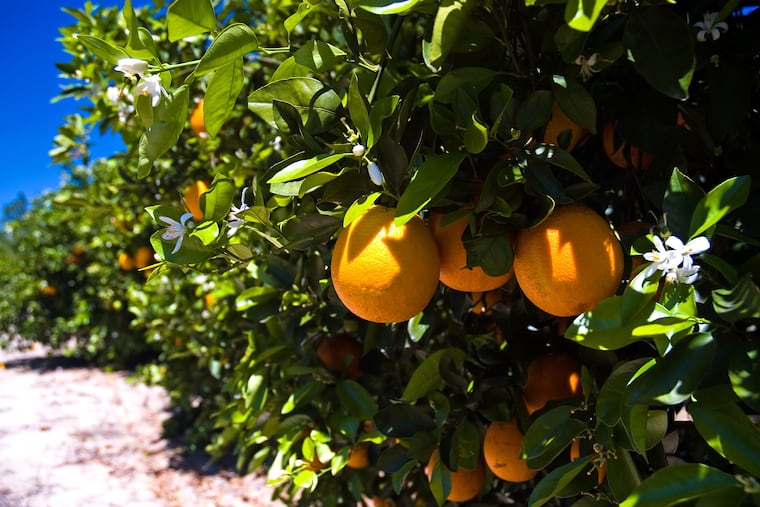As Florida citrus fades, farmers diversify with a store, a maze, and new crops
Across Florida, there were more than 400,000 acres of citrus-bearing acreage in the 2017-18 crop year, down from more than 777,000 acres in 1998-99.

UMATILLA, Fla. — A maze made of stacked citrus picking bins will serve as a nod to three generations of citrus production on land where a new agriculture attraction called Sunsational Farms is sprouting this fall.
The maze, a retail store where people can watch fresh juice be squeezed, a food barn envisioned to cook up fresh produce, and a structure where visitors can see how fruit is processed are replacing five acres of old tangerine trees and 10 acres of grapefruit devastated by citrus greening disease.
A multi-week fall festival is in the works, mini-pumpkins have been planted that the farmers are still learning about growing, and other crops are coming including strawberries, vegetables, and some citrus in seedless tangerines, seedless mandarins, and lemons.
As greening stresses trees and stunts their fruit, some Central Florida citrus farmers are seeking to attract visitors through what’s known as agritourism and planting other crops, measures they hope will keep their businesses afloat.
“You’re going to have to find some type of alternative, and agritourism just is a huge thing that’s growing right now,” said Bill Baker, one of the owners of Sunsational Farms. “Back when I was a kid, my dad said, ‘Forty acres of citrus, you could raise a family on, make good money, send your kids to college.’ Now, 400 acres of citrus, you have a hard time raising a family on.”
The changes come as hundreds of thousands of commercial citrus acres in Florida have disappeared with greening and urbanization.
Brian Faryna, his sister Lauren Sutton, and her husband, Kris, have partnered with another longtime citrus farming family, Bill and Dru Baker, to develop Sunsational Farms in Umatilla, a town along the southern border of Ocala National Forest. The farm’s name also reflects the history of the struggling Central Florida citrus industry — a now-shuttered packing house, owned by Faryna and the Suttons’ family, was called Sunsational Citrus.
Their family already runs a smaller retail store in Umatilla that will relocate to the new building on the farm along with the big orange that sits outside the smaller store.
‘You can’t sustain that forever’
Across Florida, there were more than 400,000 acres of citrus-bearing acreage in the 2017-18 crop year, down by nearly half from more than 777,000 acres in 1998-99, according to a U.S. Department of Agriculture and Florida Department of Agriculture and Consumer Services report.
Many of those lost acres are in Central Florida.
Not all of the decline in citrus over the past 20 years has been because of greening, a disease spread by the tiny Asian citrus psyllid insect that kills parts of a tree’s root system and was confirmed in Florida in 2005. Other factors such as urban development have encroached on farmland, said Michael Rogers, director and professor at the University of Florida’s Citrus Research and Education Center in Lake Alfred.
The acreage lost now and over the last 10 years, though, is largely because of people dealing with greening.
“Some look at it as, we want to get back in citrus, but right now we don’t have the confidence we could do it at this point and stay in business,” Rogers said. “For the small guys, several years of consecutive losses — you can’t sustain that forever.”
At Michael and Mary Graham’s family farm, much of their 12-acre orange grove near Umatilla has been transformed into a peach orchard.
“If we’re going to continue to be farmers, we needed to come up with something else to farm,” Mary Graham said. “We didn’t see any hope of seeing a cure for greening any time soon.”
The Graham family started growing citrus in 1918, but planted peaches in 2014. The family didn’t have a market for selling peaches once they were ready to pick in 2016, so they decided to have people pick the fruit themselves.
“I literally just started a Facebook page,” she said.
Along with the farm’s eight acres of peaches, a sunflower attraction has been added for visitors, and a 2,000-square-foot barn for parties and events like weddings is in the works. The family is also experimenting with other crops.
Closing a packing house
The Sunsational Citrus packing house employed almost 30 people during the season for much of its run and put out 225,000 90-pound cartons of fresh fruit in 2008.
It shut its doors this year after the most recent season, when it only packed 18,000 cartons.
“Every single year it just got a little bit smaller, ran a little thinner,” Faryna said. “The last three years were very disheartening for the fresh side, for the packing house.”
The packing house was part of Faryna and the Suttons’ family businesses that also includes 150 acres of their own farmland and a grove care business that has also seen the acreage it takes care of dwindle in recent decades.
Still, the families involved in Sunsational Farms don’t see the current shift in Central Florida citrus being as big as the freezes in the 1980s that decimated the crop here, even if greening makes for an uncertain future.
“Do we want to keep going as long as we can? Absolutely. Are we going to be able to? Who knows,” Kris Sutton said. “If there was another freeze here, up in this area, I don’t think anybody would replant hardly.”